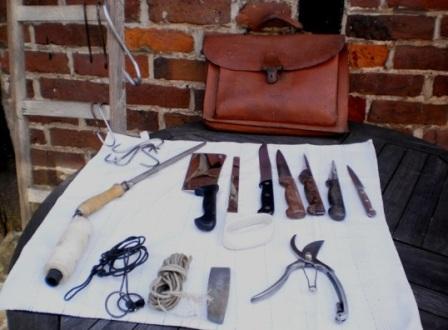A sledgehammer blow to the head followed by severing an artery (or neck cut), I believe it is the most humane way. If you've never done it the strength of a stroke is difficult to estimate. But you can not hit too hard. You may crush the skull, or teeth may fly from the jaw. But that's better than letting suffer by not (properly) killing or stunning the animal.
 A rabbit you take with one hand on the rear legs so that the head hangs down. Hold on tight (or bind, hang) or else your lunch wriggles and jumps off. With your other hand, you give a kind of karate chop down. Touch the rabbit just behind the ears. The vertebrae are so stretched and the spine broken. If you are unsure about his, use a strong, short bat. (If you don’t trust your clout, then cut off the head or stab between two vertebrae, trough the spinal cord.) You can also use a (stun) bold gun, or (usually called captive bold pistol) a pin shot by a spring, a powder pattern or air pressure through the skull. If you can find them. The pin shoots in the brain and causes permanent unconsciousness, or anesthesia. If it is to be slaughtered under anesthesia, propagated in the media, so they mean this.
A rabbit you take with one hand on the rear legs so that the head hangs down. Hold on tight (or bind, hang) or else your lunch wriggles and jumps off. With your other hand, you give a kind of karate chop down. Touch the rabbit just behind the ears. The vertebrae are so stretched and the spine broken. If you are unsure about his, use a strong, short bat. (If you don’t trust your clout, then cut off the head or stab between two vertebrae, trough the spinal cord.) You can also use a (stun) bold gun, or (usually called captive bold pistol) a pin shot by a spring, a powder pattern or air pressure through the skull. If you can find them. The pin shoots in the brain and causes permanent unconsciousness, or anesthesia. If it is to be slaughtered under anesthesia, propagated in the media, so they mean this.
Pigeon fanciers (?) know that you can reel off the head with a jerk, or press the skull with your thumb. Fowl can behead with a stroke of an ax. If you cannot hold, a larger (goose.. turkey) with one hand: two legs and two wings tops, ask for help. Tie legs together or turn the animal in a burlap bag where the neck stabs out through a hole. Or put it through a traffic cone.
Hang the animal with the hind legs (spread) into two loops. Cut the throat so that it can bleed out.
Give them time to bleed. Blood spoils quickly, and thus needs to be out of the flesh. During and after slaughter you can press and flush remnants of blood clots from the heart and veins.
The second unpleasant task: place the animal with the anus on the ground and press the soft belly, if possible, to lose the stool safely. Then it cannot spoil the meat later.
Decades ago butchers still bought a pig or cow. The animal was then proudly pinned to the shop, so that everyone could judge the quality.
In abattoirs, slaughter happening today behind walls. We will not see the link to the live animal, and are even (hypocritical) outraged about it.
The slaughterer is the man who slays, gives the final blow. So you can hear right where the word comes from. (Boner and butcher are later concepts.)
The stunning of animals before slaughter happens here since the end of 1800. Before animals were shackled and got a throat incision. (Like some religions still stand today.)
Neck stab between the occiput and the first cervical vertebra was used in more southern countries. (Some suspect that this technique would rather paralyze than make unconscious and insensible?)
The 'stunning' happened first with a pen or cow hammer: a heavy hammer or ax with a pin on the back. Also loose pins, often conveniently provided with a long handle, were used.
Later, the hollow tube came with pen. Sometimes it was a stunner with a blindfold added so that the animal could not see it coming. Still later, the pin was replaced by a ball. The name stunbold gun was retained. In order to avoid that the ball afterwards ended up in the meat grinder, it was again replaced by a hollow pin and separate cartidges. (In slaughterhouses is also electrically stunned.)
The (in) stroke is given at the intersection of two imaginary lines running from (the top of the implantation of) the ear to the other eye.
Then the animal must ASAP bleed to dead. Usually by a throat cut. Sometimes, through a slit in the longitudinal direction. Which is equally effective and less damages flesh and skin. Also, a breast stitch is sometimes applied, from the neck, 10 cm above the sternum, in the direction of the heart.
For the last two methods some experience and knowledge of anatomy are useful. They make it easier to catch the blood (because the wound is situated higher).
